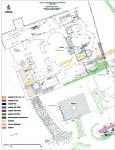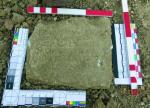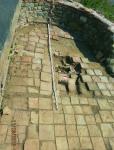Summary (English)
ST. JOHN PRODROMOS MONASTERY (Kazimir Popkonstantinov, Rossina Kostova – korina68bg@yahoo.com, Milen Nikolov) St. John Prodromos Monastery covered an area of c. 0.6 ha. Sondages were carried out in the abbot’s house, the basilica, the katholikon of the 13th century and the holy spring. Sherds of the 5th – 6th centuries AD and two sherds from Greek black-gloss vessels of the 4th – 2nd centuries BC were discovered beneath the floor in the northwestern corner of the abbot’s house. The marble threshold of the central entrance of the narthex of the katholikon was spolia. There was another spolia (a fragment of a column) incorporated in the western foundation of the narthex. A fragment from a Greek inscription in seven lines was also discovered in the katholikon. It was a decree of the 4th – 3rd century BC, specifying that prominent citizens of Heraclea Pontica became honorary representatives of their city to Apollonia, received the right to buy property there, to trade without imposing additional taxes, duties etc. This is the first document featuring diplomatic relations between Apollonia and Heraclea Pontica. A stone chamber that accommodated a reliquary was discovered in the presbytery of the basilica, related to consecration after the reconstruction during the building of the refectory to the south of the basilica in the 15th – 16th century. During that reconstruction, the southern nave of the basilica was eliminated and it was converted into a funerary church with a chapel. The southern foundation of the basilica was built over a foundation of the 5th – 4th century BC, similarly to its northern wall. A Greek sanctuary, probably of Apollo, existed on the island before the basilica and the monastery were built at the end of the 4th – 5th century AD.
- Kazimir Popkonstantinov - Department of Archaeology, Veliko Tarnovo University St. Cyril and St. Methodius
- Rossina Kostova - Department of Archaeology, Veliko Tarnovo University St. Cyril and St. Methodius
- Milen Nikolov - Regional Museum – Burgas
Director
- Kazimir Popkonstantinov - Department of Archaeology, Veliko Tarnovo University St. Cyril and St. Methodius
- Milen Nikolov - Regional Museum – Burgas
- Rossina Kostova - Department of Archaeology, Veliko Tarnovo University St. Cyril and St. Methodius
Team
Research Body
- Regional Museum – Burgas
- Veliko Tarnovo University St. Cyril and St. Methodius






![Download [PDF]](/excavation/skins/fasti/images/results/download_sml.png)

